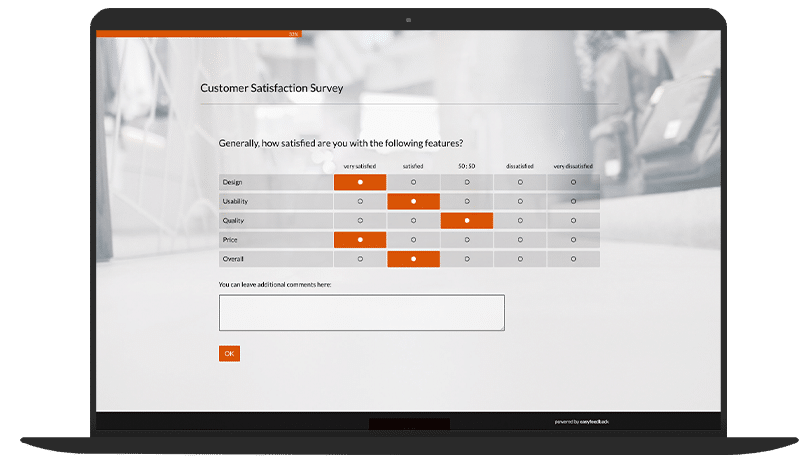What is customer journey management?
Customer journey management (CJM) refers to the process of designing, managing and optimizing the interactions a customer has with a company across various touchpoints while purchasing or using products or services.
The customer journey typically encompasses all the stages a customer goes through, from the discovery of a product or service, through the purchase process, to usage and possibly repeat purchase.
Below you will find key aspects of customer journey management:
- Consideration of all touchpoints
Companies need to identify all points of interaction that a customer might have with the company during their journey.
These can be physical locations, websites, social media, emails, customer support and other channels.

- Customer journey analysis
The customer journey is analyzed to gain insights into customer behavior and needs.
This enables companies to respond specifically to customer needs and improve their experience.
- Personalization
By understanding the customer journey, companies can create personalized interactions and offers.
This leads to greater customer loyalty, as customers feel that their needs are being considered individually.
- Optimization
Customer journey management involves the continuous optimization of interactions to ensure that customers have a positive experience.
This can include improving processes, customizing offers or implementing feedback mechanisms.
- Multi-channel approach
As customers may engage with companies through different channels, a multi-channel approach is important.
Companies need to ensure that the experience is consistent and seamless, regardless of which channel the customer uses.
What are the goals and benefits of customer journey management?
The goals of customer journey management (CJM) are focused on understanding, shaping and optimizing customer interactions and experiences with a company.

Some of the key objectives are listed below:
1. Improved customer experience
A key goal of customer journey management is to improve the customer experience at all levels.
By identifying and eliminating pain points in the customer journey, companies can ensure that customers have positive and seamless experiences.
2. Increase customer satisfaction
By better understanding what customers want and how they interact with the company, companies can adapt their products, services and processes in a targeted manner to increase customer satisfaction.

3. Promote customer loyalty
Well-designed customer journey management helps to build customer loyalty.
Through personalized approaches and positive experiences, customers will be more inclined to do recurring business with a company.
4. Optimization of sales processes
By understanding the customer journey, companies can optimize the sales process.
This can include improving sales techniques, adapting marketing strategies or implementing effective sales promotions.
5. More effective marketing strategies
Customer journey management enables companies to better tailor their marketing strategies to the needs and behavior of their target group.
This can include the personalization of marketing messages, the selection of appropriate advertising channels and the creation of relevant content.
6. Increasing sales
By creating positive customer experiences and increasing customer satisfaction, customer journey management can ultimately help to increase sales.
Satisfied customers are more likely to do repeat business and generate positive word of mouth.
7. Continuous improvement
CJM is an iterative process that aims for continuous improvement. Companies set themselves the goal of constantly optimizing their processes based on feedback and insights from the analysis of the customer journey.
What are the components of customer journey management?
Customer journey management (CJM) comprises various components that work together to understand, shape and optimize customer interactions and experiences with a company.
Here are some key components of customer journey management:
- Touchpoints analysis
Identifying and analyzing all points of contact (touchpoints) where customers come into contact with a company is crucial.
This includes physical locations, digital platforms, social media, emails, customer support and other channels.
- Create personas
By developing customer segments or personas, companies can better understand different types of customers.
This makes it easier to adapt the customer journey to the specific needs and preferences of different target groups.
- Customer journey mapping
The visual representation of the steps a customer goes through during their interactions with a company is known as a customer journey map.
This tool makes it possible to identify touchpoints, understand emotions and recognize potential pain points.
- Data analysis and tracking
The collection, analysis and evaluation of data is crucial to gaining insights into customer behavior.
Data points such as website analytics, customer reviews, sales data and customer surveys can be used for this.
- Feedback mechanisms
The implementation of feedback mechanisms, such as customer reviews, surveys or direct customer feedback, enables companies to receive continuous feedback and respond to customer needs and expectations.
- Personalization
The customization of interactions and offers based on the individual preferences behavior and needs of customers helps to create a personal and relevant customer journey.
- Multi-channel strategies
Given the diversity of today’s communication channels, it is important to ensure a consistent experience across different platforms.
A well-coordinated multi-channel strategy makes this possible.
- Customer journey analytics tools
The use of analytics tools helps companies to monitor and evaluate customer interactions in real time.
This allows them to react quickly to changes and adapt their strategies.
- Optimization and adaptation
Customer journey management is an iterative process.
Continuous optimization and adaptation based on collected insights and customer feedback help to continuously improve the customer experience.
- Employee training
Employees who interact directly with customers play a key role in delivering a positive customer journey.
Training can ensure that staff understand the importance of customer centricity and act accordingly.
What does a customer journey management framework look like?
A customer journey management framework is a structured approach that helps companies to effectively understand, design and optimize the customer journey.

This framework makes it possible to systematically analyze the interactions and touchpoints between the company and its customers.
This in-depth analysis provides valuable insights that help to better understand the needs, wishes and challenges of customers.
In addition, the framework serves as a guide for the targeted design of each phase of the customer journey.
From initial awareness to final conversion and beyond, all touchpoints are deliberately designed to ensure a seamless and positive overall impression.
This includes both digital and physical interactions to ensure that customers have a consistent and engaging experience across different channels and situations.
Continuous optimization is another key aspect of the framework.
By continuously analyzing feedback, data and market trends, the company can adapt and improve the customer journey to meet customers’ changing expectations.
This not only increases customer satisfaction, but also strengthens the company’s competitiveness in the long term.
Overall, the Customer Journey Management Framework acts as a strategic compass that supports companies in maintaining customer relationships, promoting positive brand perceptions and ensuring long-term business success.
In the following, I would like to present the essential elements of a common framework for customer journey management:
1. Defining goals and metrics
Precisely formulating the goals that the company wants to achieve through customer journey management and carefully selecting meaningful performance metrics to measure not only the progress but also the success of these goals is an essential step in the strategic direction of the company.

Clearly defining goals and establishing measurement criteria not only ensures the effectiveness of customer journey management, but also creates a solid foundation for targeted optimization.
2. Segment customers and create personas
Careful identification and fine segmentation of different customer groups form a further step in the CJM framework.
This is followed by the detailed creation of individual personas, which helps to gain a comprehensive understanding of the needs, preferences and behaviors of the specific target groups.
These detailed personas serve as vivid representations of the customers, and their design enables the company to focus not only on superficial demographics but also on in-depth psychographic aspects.
3. Analysis of the various points of contact
The careful identification of all touchpoints at which customers come into contact with the company forms a further starting point for the CJM.
In a further step, the focus is on the detailed evaluation of the significance and effectiveness of each of these touchpoint interactions.
Customer journey mapping is then used to visualize the end-to-end process from the customer’s unique perspective.
This comprehensive approach goes beyond simply mapping the steps by also highlighting the associated emotions, concerns and pain points during the interactions.
This holistic view makes it possible to capture the customer journey in its entirety and make targeted optimizations.
By highlighting emotions and pain points, an in-depth analysis is made possible in order to design and improve the customer experience in an even more targeted manner.
4. Collect and analyze data
The targeted use of systems to capture important customer and interaction data helps to gain valuable insights into customer behavior.

The goal of this analysis is not only to understand current interactions, but also to find areas for improvement.
By accurately evaluating this information, strategic decisions can be made to continuously improve the customer journey and optimize the customer experience.
5. Introduce feedback mechanisms
The deliberate establishment of feedback mechanisms, such as customer ratings, surveys and direct customer feedback, enables the comprehensive collection of feedback from customers.
This customer feedback is then decisively integrated into the optimization process.
This continuous feedback makes it possible to respond to the needs and opinions of customers and thus ensures agile adaptation of the customer journey.
6. Personalize the offer
Through the clever use of individual strategies based on the results of customer segmentation, offers and interactions are fine-tuned to the individual needs and preferences of customers.
This customized approach makes it possible to establish a personal connection with customers, increase their satisfaction and ultimately foster deep loyalty.
By dividing customers into different groups and understanding their specific characteristics and behaviors, companies can tailor their products, services and communication strategies to the needs of each group.
This leads to greater relevance of offerings to customers, which in turn increases the likelihood that they will interact with the company and ultimately become loyal customers.
7. Develop multi-channel strategies
Developing a consistent and coordinated presence across different channels ensures a seamless experience for the customer, regardless of which channel they interact with the company on.

This consistent and coordinated presence is critical not only to build customer trust and promote a positive perception of the brand, but also to deliver a consistent brand message.
By providing customers with the same messages and information across all channels, the credibility and authenticity of the brand is strengthened.
In addition, a consistent presence enables a smooth interaction that helps customers achieve their goals effectively.
When customers receive consistent information regardless of the channel they choose and can move seamlessly between channels, their overall experience is improved and they feel better cared for and supported.
This contributes to customer satisfaction and promotes long-term customer loyalty to the brand.
8. Training employees
Training employees to raise awareness of the importance of the customer journey is another step within the framework.
Through this training, employees are sensitized and understand the importance of each interaction step for customer satisfaction.

They learn how their actions and interactions can have a direct impact on the overall customer experience.
Additionally, it is of great importance to actively involve employees in the process in order to utilize their insights and experiences.
Employees who interact with customers on a daily basis have valuable insights and can provide direct feedback on their experiences.
Their involvement makes it possible to continuously improve the customer journey and better understand the needs of customers, which ultimately leads to optimized customer loyalty and satisfaction.
9. Continuous optimization
Regularly reviewing and updating the customer journey management framework is key to ensuring that it meets the ever-changing needs and expectations of customers.
Through these reviews, strategies are adapted to new data, trends and customer feedback.
This continuous adaptation allows companies to remain agile and respond flexibly to changes in the market and customer behavior.
In this way, they can ensure that their customer journey is always optimized and offers an outstanding customer experience.
Conclusion: Why is customer journey management important for companies?
The importance of customer journey management is easy to understand.
In today’s world, where customers expect a lot, it is important that companies offer personalized and seamless experiences. This is where customer journey management comes into play.
It helps companies not only fulfill customer needs, but also encourage positive interactions.
This is important for building long-term relationships with customers.
Customer journey management also enables companies to understand exactly how customers interact with their brand.
Through precise analyses, they learn which contact points are particularly important and what customers expect from products or services.
This information helps them to address customers in a more targeted and efficient manner.
The focus on the customer journey goes beyond mere interactions.
When companies create positive experiences throughout the buying process, it strengthens customer loyalty. Customers who feel valued become loyal repeat customers and tell others positively about the brand.
This has a positive long-term impact on the success of the company, as loyal customers not only return often, but also become ambassadors for the brand.
In summary, customer journey management not only offers the opportunity to meet the current needs of customers, but also to react proactively to their changing requirements.
It is like a strategic tool that helps companies not only to achieve short-term goals, but also to secure long-term competitive advantages and lasting success.
More about Customer Journey
- Customer Journey: A central component of the customer experience
- 5 steps to building an effective customer journey funnel
- The 5 phases of a Customer Journey
- 8 methods for analyzing the customer journey
- Customer Journey Map: The visualization of the customer journey
- 7 steps to a B2B customer journey strategy







